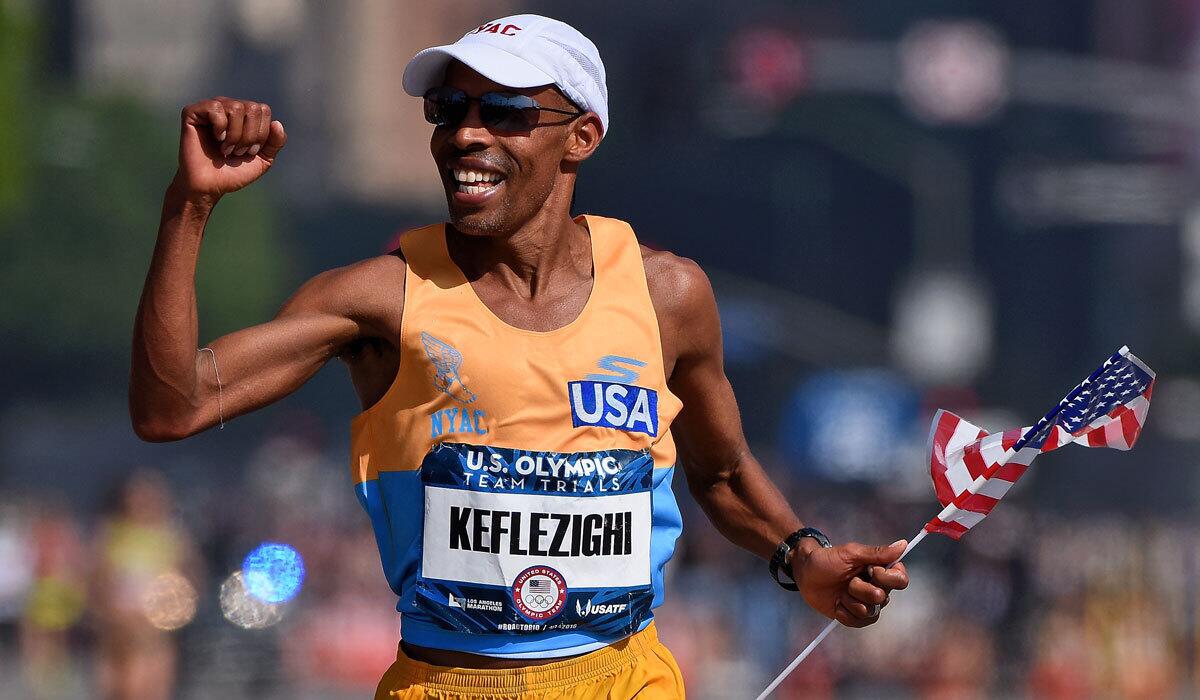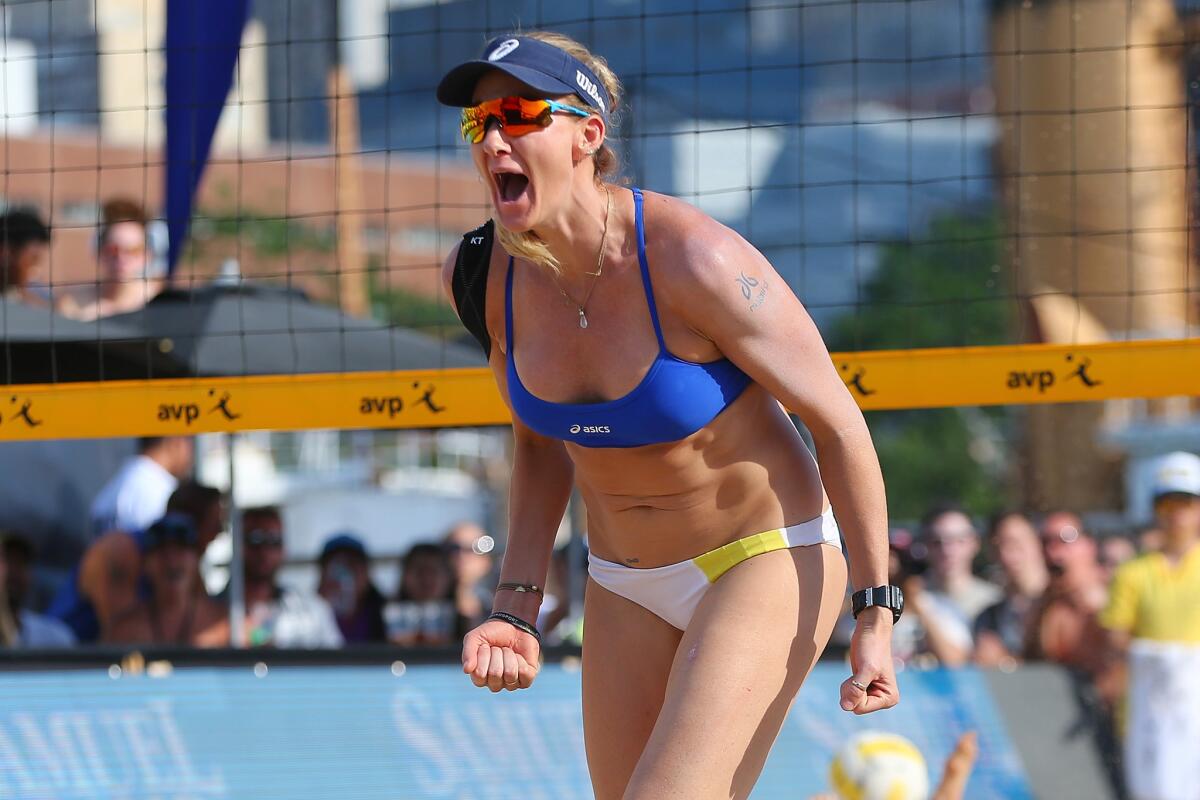Age is less of a factor as U.S. athletes are redefining longevity in Olympic sports

- Share via
Some days, when Meb Keflezighi hits the road, his legs just don’t want to move.
That is what happens to a marathoner when he reaches the comparatively ancient age of 41.
“You can’t run like you’re 25 anymore,” he says. “You’re going to have bad days.”
The fact that Keflezighi has qualified for the 2016 Summer Games in Rio de Janeiro — where he will become the oldest American Olympic marathoner — astonishes some younger runners.
“Meb is amazing,” middle-distance star Alysia Montano said. “He isn’t the norm.”
But he isn’t a rarity, either. More elite athletes are remaining competitive at an athletically advanced age.
The 40-somethings on the U.S. team headed for Brazil include runner Bernard Lagat and cyclist Kristin Armstrong, a defending Olympic champion in road racing who has come back from retirement twice.
Kerri Walsh Jennings will try for her fourth gold medal in beach volleyball at 37. That’s the same age as taekwondo athlete Steven Lopez. Race walker John Nunn and tennis players Bob and Mike Bryan are 38.
“With the science we have now, we can preserve the body and allow the physiology to go longer,” said Tim Pelot, a strength and conditioning coach with the U.S. Olympic Committee. “We have older athletes competing at a really high level.”
With each Olympics over the past three decades, the average age of the American team has crept steadily upward, from 25.2 at the 1984 Los Angeles Games to 27.1 in London four years ago.
“We’re seeing it in other sports too,” said Scott Sailor, president of the National Athletic Trainers’ Assn. “Even in sports like football.”
Much of this longevity can be attributed to advancements in conditioning and nutrition. Injuries are diagnosed sooner and treated more effectively.
“I just think we’ve come a long way with knowledge,” Walsh Jennings said. “People are training smarter and eating better.”
You can’t run like you’re 25 anymore. You’re going to have bad days.
— Marathon runner Meb Keflezighi, 41
Something else that might not seem to jibe with elite sports is helping: knowing when to take it easy.
“Recovery” is a catchphrase among top athletes. Pelot stresses paying attention to your body because those aches, pains and twinges are sending an important message.
“When fatigue happens, we can’t perform at the same capacity, so we have to adapt our workload,” he said. “We have to modify our training.”
For Keflezighi, that means dialing back on off-days to avoid over-fatigue or injury. He talks about the wisdom of knowing “you don’t have to have your A+ game all the time.”
At the relatively younger age of 30, judoka Marti Malloy has made similar accommodations in her daily regimen.
“When I was in college, I was able to wake up at 6 a.m. and do weight training then go to work and class, then go do judo,” she said. “That’s all in one day.”
Now she plans her workouts for months in advance, building up slowly, tapering down after particularly tough weeks, fitting rest time into the schedule.
“I hate saying that because it makes me feel so old,” she said. “But it’s something you have to stay on top of.”
Modern athletes have another advantage when it comes to lasting longer: money.
“Look at Mark Spitz,” said David Wallechinsky, an author and Olympic historian. “He won seven gold medals in 1972 but couldn’t make a living, so he quit swimming.”

Now, with corporate sponsors, part-time job programs and Olympic training centers such as the one in Chula Vista helping with expenses, athletes can continue training while leading reasonably comfortable lives.
“We didn’t have that kind of infrastructure when I was diving,” recalled Greg Louganis, who won five Olympic medals through the 1970s and ’80s. “It’s exciting to see athletes can continue on longer than they thought was possible.”
The final piece of the puzzle might be psychological.
Karen Cogan, a USOC psychologist, uses the history of the mile race as an example. For decades, people thought the “four-minute barrier” would never be broken, but after Roger Bannister did it in 1954, the record was lowered numerous times in ensuing years.
Now, every athlete who competes into his or her 40s is changing the mind-set in sports.
“It comes down to expectations,” Cogan said. “If someone does it, it becomes possible.”
Keflezighi ranks high among the role models.
The Eritrean native, who emigrated to the U.S. as a boy, figures luck has played a role, helping him avoid serious injury as he looks forward to his 24th career marathon in Rio.
Not an obvious medal favorite, Keflezighi remains a threat if only because of his experience. His successes have ranged from a silver medal at the 2004 Athens Games to a fourth-place finish at the 2012 London Games and a victory at the 2014 Boston Marathon.
Even on tough days, he has found a way to keep going.
“You get up the next morning and work out again,” he said. “You have to think the next day is going to be brighter and better.”
Go beyond the scoreboard
Get the latest on L.A.'s teams in the daily Sports Report newsletter.
You may occasionally receive promotional content from the Los Angeles Times.




